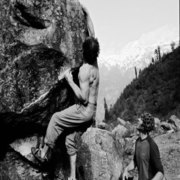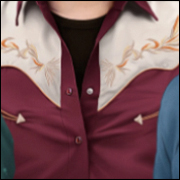|
Mons Hubris posted:My gym leaves boulders problems up about 6-7 weeks and top rope routes maybe 2-3 months. They also have 3 locations locally that the same setters rotate through, so there is essentially always something new if you're willing to drive a little bit. That's, uhh, awful. Do you at least have some sort of board or system wall? Also I started logging climbing in TFLC in case anyone is curious. The idea is to try and do 20-problem pyramids while using the base of the pyramid for deliberate practice (i.e. staying up over the feet, relaxing grip, practicing lock offs, practicing getting into hosed up boxes etc.) that peak with the 2-3 problems I'm focusing on that day. Ideally 2 would be one below max and 1 would be max grade. No more than 5 attempts per problem with massive rest in between because I suck at resting. rest his guts fucked around with this message at 22:25 on Jun 20, 2019 |
|
|
|

|
| # ? May 9, 2024 19:34 |
|
rest his guts posted:That's uhh.. awful. Do you at least have some sort of board or system wall? Since this sounds like my gym, I think you're misunderstanding. Any given problem is up 6 weeks, but there are new problems every week since they set a couple sections each week and rotate through the whole gym every 6 or 7 weeks, I think it's pretty standard.
|
|
|
|
M. Night Skymall posted:Since this sounds like my gym, I think you're misunderstanding. Any given problem is up 6 weeks, but there are new problems every week since they set a couple sections each week and rotate through the whole gym every 6 or 7 weeks, I think it's pretty standard. Yeah, that. But there is also a system wall.
|
|
|
|
I am not sure you guys climb at big gyms. The smaller ET I climb at has 400+ routes and problems set at one time. A 3 month rotation is totally fine. The other ET I can go to didn't state the numbers but it has twice the wall square footage...
|
|
|
|
Yeah the biggest one I go to has about 130 boulder problems and the other two are around 100, they arenít anywhere near like a Touchstone gym
|
|
|
|
Garbage
rest his guts fucked around with this message at 16:37 on Feb 23, 2020 |
|
|
|
rest his guts posted:Touchstone gyms are the most consistently inflated gyms ever. Three months into climbing I climbed a bunch of V6s when I was barely climbing 3s/4s at my local Bouldering Project gym (which are also inflated) and recognized immediately that their grading was meant to appease Bay-area techies. I guess I shouldn't be surprised, literally every commercial gym I've ever been to, including the one I worked at, does the same. I just can't imagine crushing that hard in a gym then going to some of the most sand-bagged destinations (JTree, Bishop) only to climb five grades below what I do in the gym. I know grade isn't supposed to matter but drat. That's how people go outside and get hurt.
|
|
|
|
I mostly climb at dogpatch but occasionally boulder at mission cliffs. I donít find MC problems to be unusually soft. DP is hit or miss, but can definitely trend soft. I think part of it is that the problems at DP are generally long, sustained, and ergonomic, so you might have e.g. a V5 thatís 15 moves of comfy V2. Outside, a V5 usually requires doing an actual V5 move and getting into an uncomfortable position.
|
|
|
|
As long as the gym is consistent in it's grading I don't really see the problem? As a newcomer to the sport I much prefer softish grades that allow me to have a nice way to gauge progression/have routes that are clearly a bit below my level, about my level and a bit over than have VB warm-up routes and then it's either never clear how hard it's going to be because v1 can be easy-ish to really hard or everything is super hard. If I compare with the Kilter Board, there's no way I would have enjoyed climbing (especially in the first 2 months) if problems were of that difficulty at v0-v1. In my gym v0 are just warm-up things I guess, v1 will give you slightly worst holds or space them appart a bit more, v2 are harder versions of v1s or introduces you to some techniques/moves. v3 starts to force you to use some techniques like flagging, drop knee, mantling, etc. and v4 and onward is actual climbing with pretty big jumps in difficulty from one to the next. I think that's an amazing way to get beginners excited and feel your progression when you first begin while introducing you to a lot of techniques that will be necessary to keep progressing. Most people probably never boulder outside anyway and if they do they probably heard that it's much harder than indoor climbing since that's hardly a secret.
|
|
|
|
KingColliwog posted:In my gym v0 are just warm-up things I guess, v1 will give you slightly worst holds or space them appart a bit more, v2 are harder versions of v1s or introduces you to some techniques/moves. v3 starts to force you to use some techniques like flagging, drop knee, mantling, etc. and v4 and onward is actual climbing with pretty big jumps in difficulty from one to the next. I think that's an amazing way to get beginners excited and feel your progression when you first begin while introducing you to a lot of techniques that will be necessary to keep progressing. Most people probably never boulder outside anyway and if they do they probably heard that it's much harder than indoor climbing since that's hardly a secret. That seems like an accurate description of how my gym is too. I also think it's a great way to encourage newer climbers; if I showed up and was stuck at a specific grade this whole time I strongly suspect I'd be much less motivated. I know it's dumb and I shouldn't focus on the numbers, but it's hard to 100% block that out. Climbing is fun no matter how you cut it, but a sense of progression is good.
|
|
|
|
Smart gyms use a grading system but don't call them V-grades so there isn't arguing over grading. Slightly related aside: Just having moved to Australia, bouldering grading is weird. Every gym I've climbed at so far uses hold colour to determine difficulty and they'll have a range, like all blue holds are for problems V2-4, rather than marking difficulty with tape colour or a tag. I find it pretty stupid because often it means you're climbing on similar holds for every single problem, especially at lower-budget gyms that can't afford massive numbers of holds in every colour. It's also kinda annoying because there's often a huge range of difficulty, such as one colour representing v3-6 for example. One could argue that grades don't really matter, but if I'm failing on a V3 I know my beta is bad, whereas on a V6 I know it's beyond my ability, and it's nice to know which.
|
|
|
|
That does seem weird, but I suppose the corollary is that it might push people to do stuff they might otherwise avoid if it was all graded like I or KingColliwog described.
|
|
|
|
Kasumeat posted:Smart gyms use a grading system but don't call them V-grades so there isn't arguing over grading. This is how the gyms in Dallas do it.There're generally 3 overlapping colors worth hopping on for people who aren't complete beginners or elites and some times you flash and some times you can't pull off the ground for problems the same color right next to each other. I think it helps the setters because it gives them an easy out when people bitch about grading inaccuracies, and gets people to try stuff they wouldn't otherwise because it's one of the colors they do. It can make it hard to judge progress though.
|
|
|
|
my gym groups Vn together and batches them up in a weird branded difficulty system it works fine. when i got my first two 5hexes though i was disappointed i couldnt conclusive say i got my first v7 somewhere between them edit: despite the colours on the grades the holds are actually not coloured by difficulty
|
|
|
|
I agree that so long as the gym strives to be internally consistent and provide linear progression that the grading shouldn't matter - unless of course you're using indoors as a metric for outdoors, which I think some people unfortunately do. I know I did, and still sort of do, in spite of myself. The idea of internally consistent grading is a bit of a pipedream, though. Like I really love my setters but what the gently caress does a V13 climber know about an intermediate anyways? But I guess my opinions about grading are sort of moot anyways - the subjectivity of grading is especially evident if you're not a normal size.
|
|
|
|
Kasumeat posted:Smart gyms use a grading system but don't call them V-grades so there isn't arguing over grading. My local gyms uses the color system, where all the V2-3 are one colour, and so forth. When I was a super beginner I loved it, it felt really accessible. It was easy to digest, and probably eased me into climbing a bit more. But you're right, it does suffer a little from having all the holds on a particular problem being very similar. I went to a gym in Stockholm recently, which used the tape system, and it was kind of annoying having to get super close to the wall to know if the problem was something I could feasibly do, but it was fun having a greater variety of holds in each problem. I dunno. I kind of like both systems. My gym recently changed its grading scale so that no colour covers a range greater than two V's either, so that's pretty cool.
|
|
|
|
rest his guts posted:That's, uhh, awful. Do you at least have some sort of board or system wall? I'd be interested in the details and how to set up my own plan if you want to do a write up.
|
|
|
|
AriTheDog posted:I'd be interested in the details and how to set up my own plan if you want to do a write up. Okay, huge post incoming. I think there's a popular way of training, a traditional way of training and the classic 20-pyramid do whatever that seems to work for most people. Right now, non-periodized linear progression is all the rage. The basic theory is that instead of dividing your training schedule into traditional training blocks (i.e., an endurance phase, a strength phase and a power phase) you do it all together. Essentially, each week is divided into a day training each energy system. Sample Non-Periodized Linear Progression Training Plan Warm-up I think generally having a consistent warm-up is a good idea, regardless of what day of training you're on. I don't think it needs to be overcomplicated - just spend 15-30 minutes climbing submaximally (at or below 50% your max grade) while deliberately focusing on skills. This is a really good time to learn to climb with your feet by actually focusing on climbing through your feet rather than your upper body. A couple of drills that I have found help with this are: -quiet feet: place your feet as gently and precisely as possible on the footholds. Before moving off your current position, identify your next series of handholds and also the spot where it would be most efficient to step on the foothold to move with as little energy expenditure as possible. As you move, think about angling your towards the hold as this will greatly help with your precision. Because the goal is to place your feet as quietly as possible, you'll be forced to weight the foot that is currently rooted (not moving) Ideally, you place your foot once, quietly (which mean -alternating between static and dynamic styles of climbing: When I'm practicing being static, I generally think about moving slowly and in control, my core and overall body tension (flexing my core, flexing my glutes, engaging my lats) and about how my feet are wrapping the hold. I might also try to do some unnecessarily big moves forcing things like lock-offs to begin to warm my body up. When praciticing being dynamic, I like to do eliminates on easy problems and focus on making big deadpoints, dynoing, and climbing quickly. -hand-foot matching: only use handholds for feet. This helps me open up my hips. -climbing big and small: try and make as small and big of moves as possible. To climb small, pretend you're a very small person. Before moving your hands, get your feet as high on the wall as possible. To climb big, pretend you're a very tall person. Keep your feet as low to the ground or as far away from your hands as possible and try to reach through to the next holds. Endurance day -Warm-up/skill work. -Repeat climbing. Find a problem at or below your onsight level, perhaps even something you've climbed before, and climb the problem repeatedly, looking for ways to improve each attempt. I like to put in 3 attempts per problem. Ordinarily I won't do more than 2-3 problems. -Onsight practice. Generally, your onsight level (what you can climb without beta) will be around 1-3 levels below your max level. On endurance days, I might try and onsight 2-5 problems in the gym at maybe V4/5 since I've climbed V7. Occasionally, there'll be a 6 that looks perfectly suited to me that I might also try and flash. Generally, on endurance days I won't try to onsight more than 3 problems because I prefer to do the bulk of my onsighting on my power days. My personal bias is that onsighting is kind of the best indication of skill-acquisition, and so I try and do a little bit of it every session regardless of what the focus of that session is. -Endurance work. Doesn't need to be complicated, but I do like running my endurance work in sets since I am boulderer. Generally I'll either do 3x10 minutes wherein the goal is to climb as many problems as possible while resting only to chalk, or 3x10 minutes wherein the goal is to climb one problem per minute on the minute. The latter variation is something I'll do when I'm closer to a trip or if I'm peaking in my training cycle, the former I'll do when I'm coming off a rest or if I'm resetting my training cycle and I need to build as much endurance as possible. I'll usually rest around seven minutes between sets. When I am doing either endurance variation, my goal is to climb smoothly and efficiently. Strength day Note: the biggest thing on strength day is to limit boulder as much as possible. I like spending around 45 minutes limit bouldering because doing much more than that makes it difficult to recover. [hang-board] Note: I'm personally more inclined to hang-board on a lifting day, but if I were to hang-board on a climbing day I'd want to do it on a strength day and probably before I spent myself training. Hand-strength is obviously critically important and it is a good idea to begin hang-boarding at some point, but maybe not for awhile. Lots of theories floating around out there about the optimal time to begin; as a rule of thumb, I would probably wait at least 6 months before beginning. -Warm-up/skill work. -Repeat climbing. No more than 2 problems; need to reserve energy for other things. -Lock-off pause practice. I like locking off and then pausing for 2-3 seconds above the hold before latching it. You'll really learn how to create body tension and stay on the wall training like this. Ideally, I do this on a 30-45* wall. -Other skill practice. E.x. suppose I have a project that has a really difficult heel-hook for me. What I like to do is go to a system wall and design my own little boulder problems trying to heel hooks that either simulate my project or are difficult for me to maintain while moving to the next hold. -Onsight practice. Maybe 3-4 problems. -Limit bouldering. Find a problem at or above your max grade in which you struggle to link more than 1-2 moves together. Try really, really hard on those moves. Your goal here is not to send but to get your rear end kicked and hopefully learn a little bit more about technique in the process. If I spend 45 minutes limit bouldering, I will usually only put in somewhere between 12-20 attempts. -Cool down. Climb 4-5 boulder problems at or below 50% your max. Try and climb efficiently and with skill. Power day -Warm-up/skill work. -Speed practice. Pick a climb at ~60% your max (If you're a V5 climber, a V3). The idea here is to find the proper box (i.e. where your body should be while moving between holds) while climbing the problem as well as you can. You should pick a climb you're familiar with or that you can easily read, spend your first attempt executing that read and perhaps making adjustments, then commit to the beta you used for the first climb through the problem for the next two attempts. Each subsequent attempt should be faster, though no less controlled, than the one prior. I generally like doing 2 problems max, as it's tedious to climb the same problem over and over again. -Dyno practice. Practice jumping. System wall is the best place for this for me. I'll generally put 3 attempts into 3 different dynos. Generally I have to be very intentional, as the amount of effort you put into here will greatly determine the efficacy of the practice. -Onsighting. 2-3 problems. -4-attempt problems: like onsighting but different. Find 2-4 problems you're reasonably confident you could do in a single session (so generally 1-2 grades below your max. Note, these recommendations begin to be less and less applicable the harder you climb*) -Mini-project session: spend 20-30 minutes on the climbs you think you can send before reset. This will likely be a problem within +/-1 of your max grade. -OPTIONAL: Campusing. I'd probably skip this for awhile, but there are plenty of sample campus workouts out there. A good starting place is to just hit every rung individually. It is becoming increasingly common for people of all ability level to only campus on the largest rungs, as the purpose of campusing is to develop max power, not contact strength. However, some people like doing both simultaneously and opt for the smaller rungs. Periodized training would look like the above but you'd spend about a month training each energy system. This means that you generally break your training cycles into three-month periods. At the end of each cycle, rest for a week or two. In non-periodized you should probably rest or at least de-load after a four-week cycle. Pyramid training generally involves climbing a set number of problems in pyramid formation. Sample V5 climber pyramid training: Quick warm-up (maybe a 10 minute traverse, or 10 minutes of climbing V0s and 1s resting only to chalk) V2, V2, V2, V2, V2 V3, V3, V3, V3 The goal here is to work on skills V4, V4, V4 Try to flash. V5/6, V5/6 Projecting/limit bouldering (alternate between the two depending on how psyched you are/goals). Don't exceed 15-20 attempts total. V3, V3, V3 V2, V2 Cool down. rest his guts fucked around with this message at 00:27 on Jun 23, 2019 |
|
|
|
To design your own training, the biggest thing to keep in mind is to try and break down climbing into its components. A good program will involve training foot-work, core-strength, body-strength, hand/tendon-strength, contact-strength and power. If you excel at one thing but not another then it might be a good idea to focus on your weaknesses. If there's a very specific project you want to climb outside, or perhaps even a style of climbing you want to excel at, it might be best to design a program wherein you're training specifically to accomplish those goals. I don't mean to belabor the point, but knowing what you're working towards is a big part of it. I'm a big believer in asking better climbers than myself about their training. I'm a big believer in anecdotal evidence, and the cadre of V13 climbers at my gym tend to think that the emphasis on training is a little silly, especially for beginners. I'm lucky enough to climb at a gym with elite setters who are also down-to-earth (a rarity), and one of them drastically simplified my approach to training with the following suggestion, 'You should be spending half your time limit bouldering and the other half split between onsighting and projecting. Warm-up and then just go do that' rest his guts fucked around with this message at 00:33 on Jun 23, 2019 |
|
|
|
I'm on a phone and am not ready to effort post (maybe ever) but that seems like a lot of thought and effort being put into what boils down to a 'do whatever' program. If you're willing to designate strength and power days with prescribed exercises, may as well try to do something with more easily quantifiable progression like campusing or hangboarding. With that being said, trying hard and 'limit' bouldering is probably the number one skill that 99% of climbers suck at and the single best way of improving if you can actually commit to it. Lots of the mega strong guys who got that way without formal training learned how to try loving hard, fail, hurt, and get scared when other people gave up. It's so much easier to just run to the shiny new set and try new problems of the exact same grade range that you're comfortable with. in related news I've been working on the moonboard problem 'hard times' on/off two years now... v6 my rear end
|
|
|
|
I'm curious how many people in here have tried the tension board? Every time I switch between plastic/the t board, I'm acutely aware of my fingers telling me that plastic is bad for them.
|
|
|
|
Ubiquitus posted:I'm curious how many people in here have tried the tension board? I think the Tboard is friendly on the skin but really nasty on the fingers. The one at my gym used to be stuck at 45 and I think feet cutting may have been more common than it would be at a less severe angle, though. There's a really cool problem called Marco Pogo where the crux is literally just a pogo into a painful crimp, and I feel like there's a lot of problems that really emphasize contact strength and punish your tendons. That said, I really like it for developing commitment, contact strength and body tension and think it excels in that department because of the slick wooden holds - the rounded footholds, especially. Like the moonboard, I think it does a really good job of forcing really explosive movement and that its friendlier on the skin. That said, it lacks variety. You're mostly climbing through your toes and the majority of the problems keep you squared up. crazycello posted:I'm on a phone and am not ready to effort post (maybe ever) but that seems like a lot of thought and effort being put into what boils down to a 'do whatever' program. If you're willing to designate strength and power days with prescribed exercises, may as well try to do something with more easily quantifiable progression like campusing or hangboarding. I don't think the non-periodized linear progression is do-whatever; ideally, you'll be doing nearly identical workouts week in and week out so progress should be fairly easy to quantify, it's just that everyone's skills training is and should be different, therefore it's hard to say what you should be doing. I've trained with pretty good success following this method of training, but am really bored of having to commit to certain drills when I just want to try hard. And yeah, most good climbers I've spoken with agree that most people would benefit from more limit bouldering. I've seen plenty of relatively out of shape people climb well into V8 through sheer commitment alone. Nothing replaces a strong mental game and genuine passion of the sort that allows you to persist in spite of (perceived) failure. When I was working at the gym I climb at I once saw one of our local pros project a V10 for two hours, leave to go set at his gym, then come back and project it for two more. He didn't back off the problem until it was done, then he wen't home. The man's climbed numerous 5.14Cs and V14s and had 0 ego about it - wasn't drawing attention to himself, wasn't complaining about what a sandbagged pile of poo poo the climb was - he was just obsessed with finding a solution. Similarly, I once saw Drew Ruana come into our gym and day-flash an insanely hard climb I'd seen him take numerous attempts on a few days prior. He then sent all the other hard problems and left to go clear all the other local gyms. Both of these events left a strong impression on how I think about effort. rest his guts fucked around with this message at 10:30 on Jun 23, 2019 |
|
|
|
rest his guts posted:I think the Tboard is friendly on the skin but really nasty on the fingers. The one at my gym used to be stuck at 45 and I think feet cutting may have been more common than it would be at a less severe angle, though. There's a really cool problem called Marco Pogo where the crux is literally just a pogo into a painful crimp, and I feel like there's a lot of problems that really emphasize contact strength and punish your tendons. I agree with you, but I meant from a long term perspective. Over time, is the t board going to generally induce more or less finger injury than plastic? Say the wooden holds were used everywhere throughout the gym, and in another gym the tensions holds were used. Which gym would have a higher rate of dinger injury? If everything else were constant. I'm inclined to say the gym with the tension holds would cause less injury. Of course they are not optimal to be used outside the board, but assuming there were different hold types using wood holds. I believe due to the density of the wood (or some other factor I've been unable to isolate), the wood holds will cause less injury. Unfortunately this is only my anecdotal sense, as my fingers feel more tweaked by the plastic holds my gym uses, and maybe those are just old and made at angles that stress the tendons with force in directions that cause higher rates of injury.
|
|
|
|
I know I posted like a week ago about buying a crash pad, but now I've got some analysis paralysis after looking at the options more. Any suggestions for something up to $250? Also, I've seen a few reviews on some suggesting "also works great under a sleeping bag" but doesn't that wear out the foam?
|
|
|
|
Buy Organic. Josh is awesome.
|
|
|
|
I use 2x Hero pads from Asana plus the smaller Pro Spotter pad to fill cracks. If I could do it again, Iíd buy a Superhero Highball, a Hero, and a Pro Spotter instead. If I went Organic Iíd opt for a Big Pad, a Full Pad and a Briefcase pad. The biggest thing Iíve learned about pads is that bigger is almost always better, regardless of approach. Once youíre highballing, which will be hard to avoid depending on where youíre climbing, you just want as much reassurance as possible and huge pads deliver I also generally hike all three pads when I go alone or am meeting with the homies and itís a pretty chill load. rest his guts fucked around with this message at 15:59 on Jun 24, 2019 |
|
|
|
How do you bundle multiple pads together? That sounds awkward and heavy  And I assume "highballing" is just like any boulder over ~15 feet?
|
|
|
|
Sab669 posted:How do you bundle multiple pads together? That sounds awkward and heavy Asana designed theirs to stack on top of each other and the weight isn't so bad. The approach to my usual spot is around 45 minutes of uphill hiking and I've yet to have any serious complaints. I'd rather be slightly tired out before climbing than worried I'm gonna miss my landing zone while climbing. And yeah highballing is just big climbing. While it eludes easy categorization, I think it begins at whatever height you are personally afraid to climb to
|
|
|
|
So I wanted to try to master muscle-ups (for fun, not necessarily for relevance to climbing though I guess they help with mantling a bit). I think I'd like to try using one of those Theraband type things to do assisted reps while I work up to a full-on muscleup. The therabands themselves seem like they're a little short and possibly not heavy enough to work wrapped around a pullup bar, though. Can anyone recommend some specific product that might do the trick?
|
|
|
|
Zephro posted:So I wanted to try to master muscle-ups (for fun, not necessarily for relevance to climbing though I guess they help with mantling a bit). I think I'd like to try using one of those Theraband type things to do assisted reps while I work up to a full-on muscleup. The therabands themselves seem like they're a little short and possibly not heavy enough to work wrapped around a pullup bar, though. Can anyone recommend some specific product that might do the trick? Hang a pulley from the pullup bar, put on your harness, tie weight to a cord, loop it through the pulley, and clip it to your harness.
|
|
|
|
Zephro posted:So I wanted to try to master muscle-ups (for fun, not necessarily for relevance to climbing though I guess they help with mantling a bit). I think I'd like to try using one of those Theraband type things to do assisted reps while I work up to a full-on muscleup. The therabands themselves seem like they're a little short and possibly not heavy enough to work wrapped around a pullup bar, though. Can anyone recommend some specific product that might do the trick? Having recently worked up to a ring muscle up, I don't think it's worth using banded assistance. Find something to stand on and jump into the muscle-up to work the transition, jump less or lower the thing you're standing on to increase the difficulty and focus on chest to bar pull ups to build explosiveness. The muscle-up's a skill and you'll see the most benefit from working it without direct assistance IMO. You can google baby muscle-ups for a bunch of examples of people using that method.
|
|
|
|
Thanks. If there's a way to do it without gear, even better. The jumping muscle-ups sound like a good idea, I might try them. My local gym has a bunch of boxes that would be perfect for that. I'm guessing the hardest bit is going to be the transition from a low jump to doing it from a dead-hang, though, right? It feels like even a small amount of momentum would make things dramatically easier.
|
|
|
|
Zephro posted:Thanks. If there's a way to do it without gear, even better. The jumping muscle-ups sound like a good idea, I might try them. My local gym has a bunch of boxes that would be perfect for that. Yeah, it's easier to adjust difficulty on the rings since you can adjust the height on them a lot easier than a bar, but basically I would do reps where I would curl my toes underneath myself with my knees bent a little so I couldn't really push much, but enough to get through the transition. That plus weighted pull-ups eventually got me to the full muscle-up. I think developing the explosiveness did end up helping my climbing, although actually working for it left me feeling weak pretty much every time I went to climb, and I had a bout of climber's elbow because 3 ring workouts a week + 2 climbing days is probably not the best plan for elbow health.
|
|
|
|
Another dumb question; tore open my first good callous tonight. Do I just grit my teeth and rip off the loose skin, or...?
|
|
|
|
Sab669 posted:Another dumb question; tore open my first good callous tonight. Do I just grit my teeth and rip off the loose skin, or...? New climber, but not new to having blisters/callousues come off: Are you at the gym/crag right now? Tape it up. No? Either cut it with scissors or tear it off. It will eventually come off anyway. Make sure to use triple antibiotic ointment today since it's on your hand.
|
|
|
|
Sab669 posted:Another dumb question; tore open my first good callous tonight. Do I just grit my teeth and rip off the loose skin, or...? Cut it off as close to the hand as possible. Tearing has the likelihood of ripping off more attached skin and that sucks more than the callous. If you want to really seal it up slather some liquid NuSkin on it
|
|
|
|
Zephro posted:Thanks. If there's a way to do it without gear, even better. The jumping muscle-ups sound like a good idea, I might try them. My local gym has a bunch of boxes that would be perfect for that. https://m.youtube.com/watch?v=6v6IsZcvqCA
|
|
|
|
Scissors it is. On the bright side, almost completed that V4 I posted last week
|
|
|
|
Sab669 posted:Scissors it is. On the bright side, almost completed that V4 I posted last week Are you stuck on the same sequence you posted and if so do you want beta? rest his guts fucked around with this message at 18:17 on Jun 25, 2019 |
|
|
|

|
| # ? May 9, 2024 19:34 |
|
I already know the beta, more or less, it's just a matter of practicing the actual moves. I haven't given that problem too many attempts since posting my video last week until last night. The gym posts some problems on their Facebook showing off a problem each time they set a wall; video I got to the hold that he matches on at 15 seconds into that video before my feet slipped off and I just couldn't get back on, tore open my callous and called a night. Thanks though 
Sab669 fucked around with this message at 18:50 on Jun 25, 2019 |
|
|


























